
|   |

|   |
Pt. Birju Maharaj Mahotsav hosted by Nandkishore Cultural Society - Kiran Java e-mail: kiran@kiranjava.com Photos: Suresh Taralgatti June 3, 2022 The Nritya Samrat Pt. Birju Maharaj Nrithya Mahotsav Kathak Mahayagya Dance Festival was organized by Nandkishore Cultural Society as a tribute to the legacy of Kathak maestro Pt. Birju Maharaj, who passed away in January this year. The inaugural event was held at the Pt. Jawaharlal Nehru Auditorium in Pune on May 14, 2022. The dance festival ran over three days with performances by legendary artistes, an awards ceremony, and student workshops. Eminent dancer/scholar Dr. Shovana Narayan and ace performer and torchbearer of Lucknow Gharana, Pt. Deepak Maharaj, performed at the event. Shovana Narayan and Pt. Deepak Maharaj were felicitated with the first edition of the Nritya Samrat Pt. Birju Maharaj Award. Workshops for students were conducted by Shovana Narayan, Pt. Deepak Maharaj, and Dr. Nandkishore Kapote.  Dr. Shovana Narayan and Pt. Deepak Maharaj felicitated with Nritya Samrat Pt. Birju Maharaj Award Dr. Nandkishore Kapote, a prime disciple of Pt. Birju Maharaj, learned from the maestro at Kathak Kendra, Delhi, in the late 1970s. At the event, Dr. Kapote spoke about accomplishing his dream of establishing Nritya Samrat Pt. Birju Maharaj Nrithya Mahotsav. He explained, "When my Guru Pt. Birju Maharaj, sadly passed away at the beginning of the year, the Maharashtra Press had asked me about the plans I had to pay homage to the memory of my Guru. I promptly responded that I would host a dance festival and establish an award in my Guru's memory, as well as conduct workshops to share my Guru's teachings." Dr. Kapote expressed his gratitude to Dr. Shovana Narayan and Pt. Deepak Maharaj for their readiness to perform at the event in Maharashtra and to accept the first edition of the awards. Shovana Narayan began her performance with the Saraswati Vandana (Ode to Goddess Saraswati) followed by uthan, thaat with a graceful attitude, an impressive tez-amad, tukadas and paran (a variety of forceful compositions danced with vigor). She also performed the gat-nikas, gat-bhav, and various Kathak bandish (compositions) from the classic paramparik (traditional) repertoire. Dr. Narayan mentioned that she was presenting items that she had learned from her Guru, Pt. Birju Maharaj, as well as some that she had developed further. 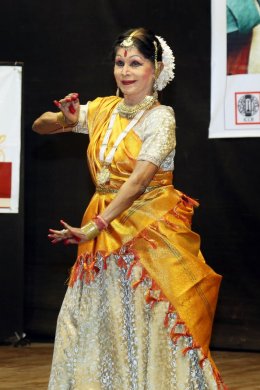 Dr. Shovana Narayan presenting the 'Shiv Abhushan' bandish Dr. Narayan presented a charming 'Shiv Abhushan' bandish and 'Hariyat paran' that featured Shiva's damru and Krishna's flute. Her 'Ghode ki taap ki bandish', a horse's gait composition that alternated between a three-beat canter and a four-beat gallop, captivated the audience. She danced the 'Jhoola Paran' - Radha and Krishna swinging in a decorated swing. In the gat-nikas section of her performance, Shovana Narayan presented the 'seedi gat' and in the gat-bhav section, she staged the 'Draupadi vastra haran' - an episode from the Mahabharata. She showcased the well-known five ghunghat-gat bhav - five different ways of opening the veil, a spectacular item from the Lucknow Gharana repertoire that can be successfully portrayed only by a very accomplished Kathak dancer, a delectable aesthetic experience. She concluded her performance as young Yashodhara, the wife of Prince Siddharth (Gautam Buddha). She shared a story about when she first staged Yashodhara in 1978 at Kamani Auditorium in Delhi, and an audience member corrected her pronunciation of Yashodhara to Yashoda. In her serene and cheerful manner she explained that she wasn't performing Krishna's mother Yashoda, but Prince Siddhartha's wife Yashodhara. Shovana Narayan was a class apart, holding the audience's attention with her easy banter and reference anecdotes. It was a tremendous treat to see her in action. The impact of Dr. Narayan's performance was heightened by Madho Prasad's singing and Shakeel Ahmed on the tabla - prominent Delhi musicians who accompany many of her performances. 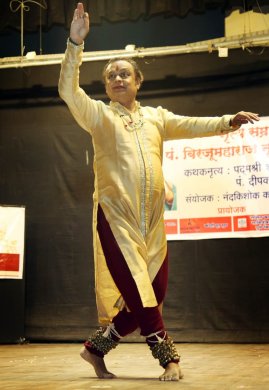 Pt. Deepak Maharaj in the 'Sudhang' posture Deepak Maharaj too brought to Pune the stylized paramparik Kathak as taught to him by his father Pt. Birju Maharaj. A seasoned dancer, he began his presentation with 'Mahadeva Shiva Shambho', a delightful Shiva Vandana, followed by the upaj and thaat, which he referred to as 'Khade hone ka andaaz' (postured standing positions). He enthralled the audience with the traditional 'takit takit ghin' ladi composed by Pt. Birju Maharaj. He explained how this ladi was created to reflect the moving rhythm of a train - and indeed with the way Deepak Maharaj executed it, one could hear the rhythm of a train in the auditorium. He then followed the ladi with a tihai which displayed three emotions - old age, youth, and infancy. It was a delight to hear Deepak Maharaj recite the bols that were to be danced in precise intonation and marked the time of the tala with his hand claps. His famed 'taav thunga takita thunga' composition from the Lucknow Gharana was an intricate footwork composition that referenced the Radha Krishna ched-chad emotion. His nritta conveyed a sense of pure joy in movement and rhythm. The audience relished his arresting presentation because of his precise rendering of rhythmic patterns by the feet and graceful limb movements. He performed a number of tihais and a parmelu which cleverly blended various sound syllables. He spiced up each performance, by telling stories of how his father had composed an item or his way of having taught an item or general guidance from Pt. Birju Maharaj. With Deepak Maharaj, it was truly an evening to celebrate the larger-than-life art of Pt. Birju Maharaj. For one of the compositions, he explained how his father had created the bols so that the 'shape and form' of the bols can be actually visualized (isi tarah sajaya hai bolon ko ki aakrti dikhati hai). He presented his ancestor Bindadin Maharaj's famous Thumri - 'Kanha dekho thade hain braja ki ora' wherein he brilliantly registered the nuances of the deliberations of a gopi. He ended with an arresting jugalbandi with eminent tabla player Pranshu Chaturlal followed by his signature 'na dhin dhin na - khade pair ki bandish' (footwork on a raised foot) that he is well-known for. In response to resounding requests from the audience, Pt. Deepak Maharaj enacted the makhan chori gat-bhav. He has beautifully expanded Birju Maharaj's makhan chori and aesthetically executed it. Deepak Maharaj was pleased with the musicians from Maharashtra that accompanied his performance, who he said were abundantly blessed by Goddess Saraswati. He praised the singer Shubham Khandalkar, flautist Dhaval Joshi and Umesh Purohit on the harmonium. He had rehearsed with them the night before and had the opportunity to teach Shubham Khandalkar how to sing the Thumri in the Lucknow Gharana manner, which would be appropriate for the dance performance. 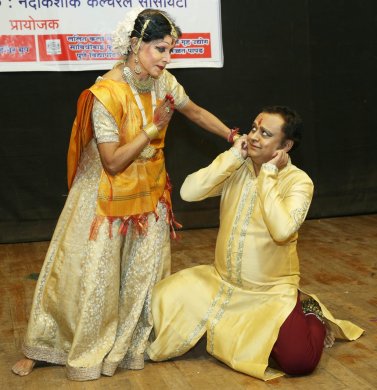 Dr. Shovana Narayan and Pt. Deepak Maharaj pose as Yashoda and Krishna All three workshops by Dr. Shovana Narayan, Pt. Deepak Maharaj, and Dr. Nandkishore Kapote were well attended and students learned material from Pt. Birju Maharaj's teachings. Shovana Narayan taught a special Ashva chala paran that was based on the gait of a horse with interesting bols, such as 'taka taka', 'ghe ghe na na ghe ghe tita' that simulated the trot of a horse. 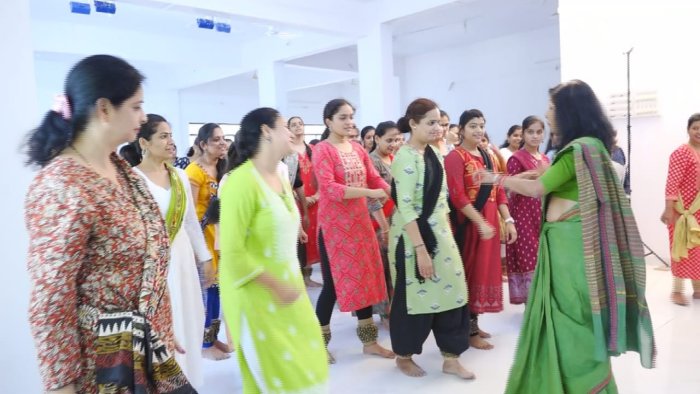 Dr. Shovana Narayan teaches tihais at the workshop She also taught several tihais and an exquisite kavitt that she has composed herself. The wordings were splendidly rhythmic - tat tat tarakata, tha ri ri ri thirakata, dam dam dam dam damini damakat She impressed upon the students the fact that in a kavitt various gestures are used to convey the meaning whilst the laya is marked by the feet. And although the abhinaya is evident, kavitt falls under nritta aspect because of its predominance of rhythmic patterns. At her workshop, Shovana Narayan also spoke briefly about her newly released book 'Kathak Lok' and presented a copy to Dr. Nandkishore Kapote for the Pt. Birju Maharaj Library which he has established. 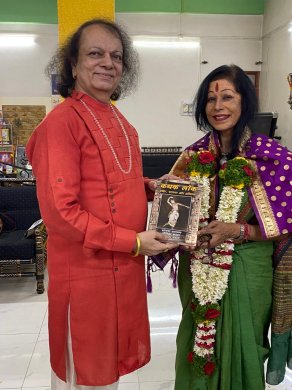 Shovana Narayan presents her newly released book 'Kathak Lok' to Dr. Nandkishore Kapote Deepak Maharaj emphasized Pt. Birju Maharaj's teachings from the latter's massive work - the 'Ang Kavya' text, which focuses on body lines and posture. He claimed that no matter how much time passed by, the elegance of the Lucknow Gharana will never fade. He demonstrated how postures can create beautiful shapes, much like a painting, and impressed upon the students the importance of 'nazar', or eye glance. He taught them thaat, amad, paran and several tihai. He also taught Nandikeswara's shloka - angikam bhuvanam yasya, vachikam sarva vangmayam. 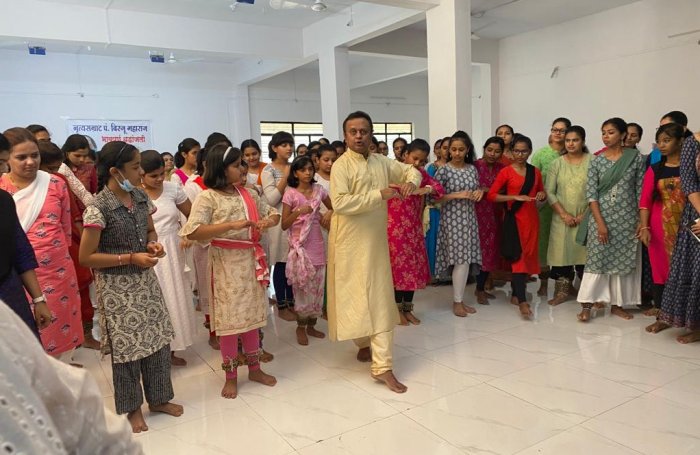 Deepak Maharaj emphasized Pt. Birju Maharaj's teachings at his workshop Dr. Nandkishore Kapote taught 'Dagar chalat dekho shaam kar gahiyaan re', a Lucknow Gharana thumri that he had learned from Pt. Birju Maharaj. This thumri written by Bindadin Maharaj is a classic piece that portrays finer nuances of bhav and abhinaya - shades and nuances that only Pt. Birju Maharaj could show how to unfold. Students at the workshop were fortunate to learn this rare thumri with the 'ang' of Pt. Birju Maharaj from his prime disciple Dr. Kapote. He also taught a few tihai that he had composed along with Radha Krishna 'ched chaḍ' gat-bhav as he had learned it from Pt. Birju Maharaj. 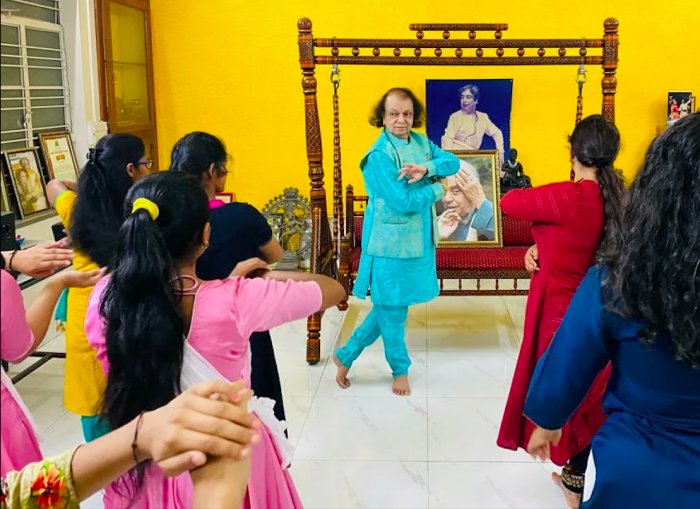 Dr. Nandkishore Kapote teaches a traditional Thumri  Dr. Nandkishore Kapote, Dr. Shovana Narayan and Pt. Deepak Maharaj According to Deepak Maharaj, the event was an opportunity to remind students and the audience of his father's memories and teachings. He and Shovana Narayan thanked Dr. Nandkishore Kapote for arranging this Mahotsav, which was a fitting tribute to Pt. Birju Maharaj's legacy, and expressed their wish that the festival would grow in size with each passing year. 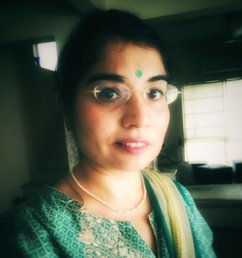 Kiran Java is a writer and is pursuing a Masters degree in Journalism and Communication. She is also curator-editor at Pushtimarg Studies. She has a Diploma in Natyashastra with Kathak relevancy under Dr. Puru Dadheech and certification in Vallabh Vedanta from Mumbai University. |